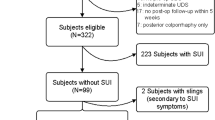Abstract
Introduction and hypothesis
Recommending prophylactic anti-incontinence procedures to continent women undergoing surgery for pelvic organ prolapse (POP) is controversial. We hypothesized that testing for occult incontinence before surgery using four different tests and three defined test combinations would identify individual women at risk for postoperative stress urinary incontinence (POSUI). The diagnostic accuracy of these tests and test combinations were evaluated.
Methods
We tested 137 women before and after surgery. Fisher’s exact test was used when evaluating associations between test results and outcomes. The validity of each test and test combinations was calculated.
Results
We found a statistically significant association between occult incontinence and POSUI in two tests and all test combinations. However, all tests and test combinations displayed poor performance when predicting at individual levels.
Conclusions
This study confirms a positive association between occult incontinence and POSUI. Occult incontinence does not, however, adequately identify individual women in need of prophylactic anti-incontinence surgery when undergoing POP repair.

Similar content being viewed by others
References
Borstad E, Rud T (1989) The risk of developing urinary stress-incontinence after vaginal repair in continent women. A clinical and urodynamic follow-up study. Acta Obstet Gynecol Scand 68:545–549
Brubaker L, Cundiff GW, Fine P et al (2006) Abdominal sacrocolpopexy with Burch colposuspension to reduce urinary stress incontinence. N Engl J Med 354:1557–1566
Ellstrom Engh AM, Ekeryd A, Magnusson A, Olsson I, Otterlind L, Tobiasson G (2011) Can de novo stress incontinence after anterior wall repair be predicted? Acta Obstet Gynecol Scand 90:488–493
Groutz A, Gold R, Pauzner D, Lessing JB, Gordon D (2004) Tension-free vaginal tape (TVT) for the treatment of occult stress urinary incontinence in women undergoing prolapse repair: a prospective study of 100 consecutive cases. Neurourol Urodyn 23:632–635
Visco AG, Brubaker L, Nygaard I et al (2008) The role of preoperative urodynamic testing in stress-continent women undergoing sacrocolpopexy: the Colpopexy and Urinary Reduction Efforts (CARE) randomized surgical trial. Int Urogynecol J Pelvic Floor Dysfunct 19:607–614
Liang CC, Chang YL, Chang SD, Lo TS, Soong YK (2004) Pessary test to predict postoperative urinary incontinence in women undergoing hysterectomy for prolapse. Obstet Gynecol 104:795–800
Ghoniem GM, Walters F, Lewis V (1994) The value of the vaginal pack test in large cystoceles. J Urol 152:931–934
Gordon D, Groutz A, Wolman I, Lessing JB, David MP (1999) Development of postoperative urinary stress incontinence in clinically continent patients undergoing prophylactic Kelly plication during genitourinary prolapse repair. Neurourol Urodyn 18:193–197
Gregorio G, Hillemanns HG (1990) Urethral closure function in women with prolapse. Int Urogynecol J 1:143–145
Klutke JJ, Ramos S (2000) Urodynamic outcome after surgery for severe prolapse and potential stress incontinence. Am J Obstet Gynecol 182:1378–1381
Richardson DA, Bent AE, Ostergard DR (1983) The effect of uterovaginal prolapse on urethrovesical pressure dynamics. Am J Obstet Gynecol 146:901–905
Rosenzweig BA, Pushkin S, Blumenfeld D, Bhatia NN (1992) Prevalence of abnormal urodynamic test results in continent women with severe genitourinary prolapse. Obstet Gynecol 79:539–542
Bergman A, Koonings PP, Ballard CA (1988) Predicting postoperative urinary incontinence development in women undergoing operation for genitourinary prolapse. Am J Obstet Gynecol 158:1171–1175
Kulseng-Hanssen S, Borstad E (2003) The development of a questionnaire to measure the severity of symptoms and the quality of life before and after surgery for stress incontinence. BJOG 110:983–988
Bossuyt PM, Reitsma JB, Bruns DE et al (2003) Towards complete and accurate reporting of studies of diagnostic accuracy: the STARD initiative. Clin Chem Lab Med 41:68–73
Pepe MS, Janes H, Longton G, Leisenring W, Newcomb P (2004) Limitations of the odds ratio in gauging the performance of a diagnostic, prognostic, or screening marker. Am J Epidemiol 159:882–890
Daneshgari F, Kong W, Swartz M (2008) Complications of mid urethral slings: important outcomes for future clinical trials. J Urol 180:1890–1897
deTayrac R, Gervaise A, Chauveaud-Lambling A, Fernandez H (2004) Combined genital prolapse repair reinforced with a polypropylene mesh and tension-free vaginal tape in women with genital prolapse and stress urinary incontinence: a retrospective case–control study with short-term follow-up. Acta Obstet Gynecol Scand 83:950–954
Ballert KN, Biggs GY, Isenalumhe A Jr, Rosenblum N, Nitti VW (2009) Managing the urethra at transvaginal pelvic organ prolapse repair: a urodynamic approach. J Urol 181:679–684
Chaikin DC, Groutz A, Blaivas JG (2000) Predicting the need for anti-incontinence surgery in continent women undergoing repair of severe urogenital prolapse. J Urol 163:531–534
Kleeman S, Vassallo B, Segal J, Hungler M, Karram M (2006) The ability of history and a negative cough stress test to detect occult stress incontinence in patients undergoing surgical repair of advanced pelvic organ prolapse. Int Urogynecol J Pelvic Floor Dysfunct 17:27–29
Brubaker L, Nygaard I, Richter HE et al (2008) Two-year outcomes after sacrocolpopexy with and without burch to prevent stress urinary incontinence. Obstet Gynecol 112:49–55
Myers DL, Lasala CA, Hogan JW, Rosenblatt PL (1998) The effect of posterior wall support defects on urodynamic indices in stress urinary incontinence. Obstet Gynecol 91:710–714
Acknowledgement
Study assistance from Øystein Bjørnerud, urotechnician at Department of Urology, Oslo University Hospital, contributing to the preoperative testing and data collection, is greatly appreciated.
Financial Disclosure/Conflicts of Interest
R. Svenningsen: None; Ellen Borstad has received speaker fees from Pfizer, Astellas, and Lilly and served on advisory boards for Astellas and Lilly; Anny Spydslaug has received speaker fees and served as paid consultant for Pfizer; L. Sandvik: None; AC Staff: None
Author information
Authors and Affiliations
Corresponding author
Rights and permissions
About this article
Cite this article
Svenningsen, R., Borstad, E., Spydslaug, A.E. et al. Occult incontinence as predictor for postoperative stress urinary incontinence following pelvic organ prolapse surgery. Int Urogynecol J 23, 843–849 (2012). https://doi.org/10.1007/s00192-012-1764-5
Received:
Accepted:
Published:
Issue Date:
DOI: https://doi.org/10.1007/s00192-012-1764-5




